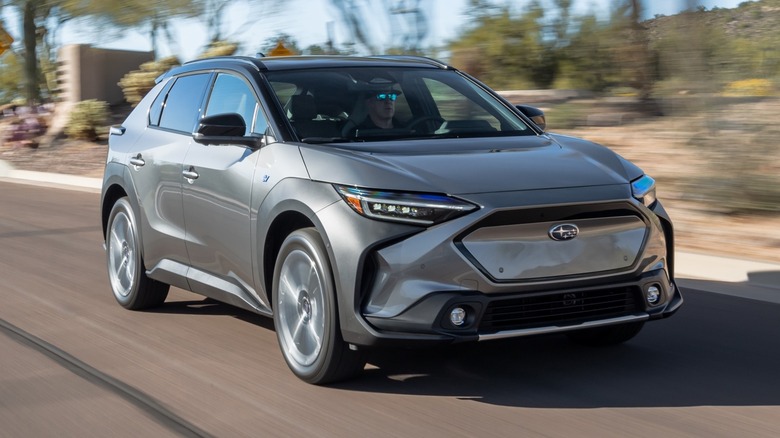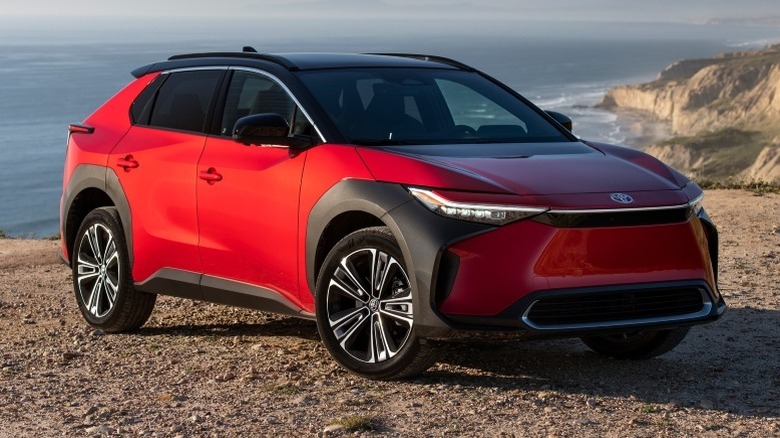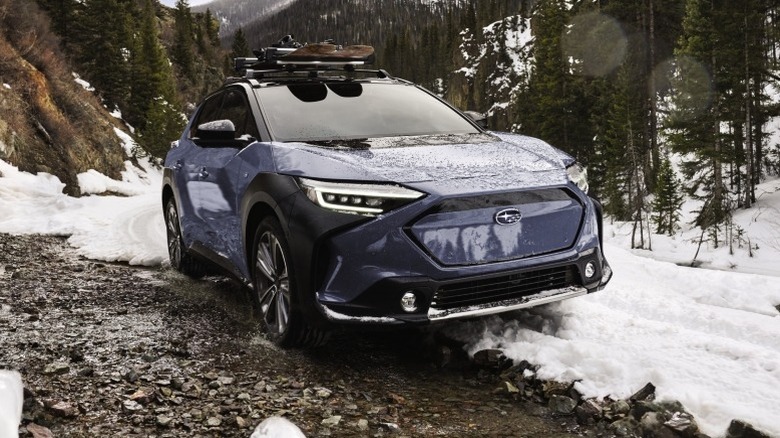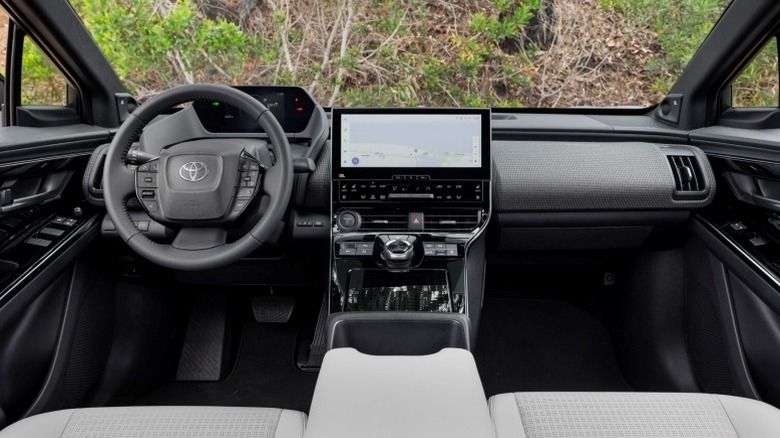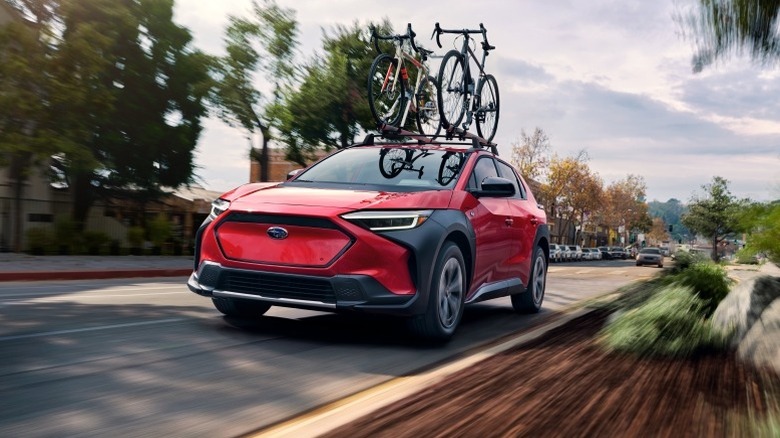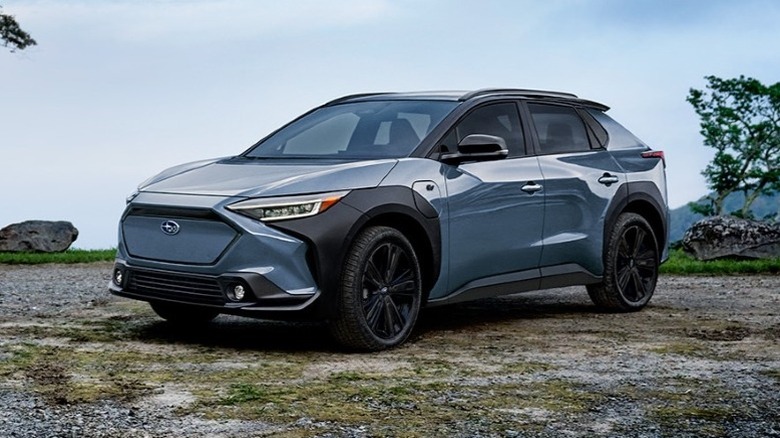Subaru Solterra Vs. Toyota bZ4X: What's Different Between These EVs?
The Subaru Solterra and Toyota bZ4X are both products of Subaru and Toyota's long-standing partnership to co-develop well-stocked cars at highly affordable prices. The two compact SUVs share a modular platform designed solely for electric vehicles. Toyota's variant of the platform is called e-TNGA, while Subaru refers to its own version as the e-Subaru Global Platform (e-SGP). Alongside the Solterra and bZ4X, the dedicated EV platform underpins vehicles such as the Toyota bZ3, Lexus RZ, and the Europe-bound Toyota C-HR+, which will be positioned under the bZ4X in the Japanese marque's range.
Externally, the platform-sharing crossovers look similar, although Subaru made slight styling changes in its attempt to give the Solterra a different identity. They're dimensionally identical too, with both measuring 184.6 inches in overall length, 73.2 inches in width, and 65 inches in height. Of course, that also means they both ride on the same 112.2-inch wheelbase.
Their shared similarities mean that these two are likely to be on your radar if you want a compact electric crossover SUV that's adequately spacious, reasonably zippy around town, and affordably priced. But there are differences between the Subaru Solterra and Toyota bZ4X that you should know about before you hand over your deposit.
The Toyota bZ4X is $1,425 cheaper than the Subaru Solterra
The 2025 Toyota bZ4X is available in three trim levels: XLE, Limited, and Nightshade. Of these, the XLE is the cheapest grade, with its msrp starting from $37,070. The Nightshade trim, for its part, begin at $40,420, while the range-topping Limited grade carries a $41,800 sticker price. With the Subaru, there are four trim levels to choose from, including the Premium, Limited, Touring, and Touring Onyx Edition.
Compared with the bZ4X, the Subaru has a slightly higher but palatable price point, with the base Solterra Premium trim beginning at $38,495. The Limited and Touring trims cost $41,995 and $44,995, respectively, while the range-topping Touring Onyx Edition will set you back at least $45,495.
No matter the trim level, all Toyota bZ4X and Subaru Solterra buyers will receive a three-year or 36,000-mile basic warranty, whichever comes first. And as for the electric vehicle drive components warranty, both manufacturers cover at least eight years or 100,000 miles.
The Subaru Solterra offers standard all-wheel drive and is the more powerful of the two
Between the Toyota bZ4X and Subaru Solterra, the latter has slightly more power you can call upon. That's thanks to two electric motors energized by a 72.8-kWh lithium-ion battery pack to deliver 215 horsepower and 249 lb-ft of torque. The electric motors are placed on the front and rear axles, which gets you all-wheel drive by default. The Toyota bZ4X, by comparison, makes 214 horsepower and 248 lb-ft in its highest state of tune, with that power coming from the optional dual-motor AWD models motivated by a 72.8-kWh battery pack. In standard form, the bZ4X is front-drive only, and it comes with one electric motor energized by a 71.4-kWh battery pack to produce 201 hp and 196 lb-ft of torque.
Against the clock, the Subaru Solterra accelerates from zero-to-60 mph faster than the Toyota bZ4X in 6.1 ticks, according to a Car and Driver testing. That's 0.3 seconds quicker than the dual-motor Toyota bZ4X, which needs 6.4 seconds to reach the same speed. The Toyota bZ4X is the undisputed range champion, however. In XLE guise, it has an EPA-estimated driving range of 252 miles. The bZ4X Limited trim, meanwhile, has a maximum driving range of 236 miles on a single charge, while the bZ4X Nightshade grade is good for up to 222 miles.
With the Subaru Solterra, you're looking at 227 miles at the higher end of the range, and this applies only to the Premium trim. The Solterra Limited, Touring, and Touring Onyx Edition are all rated to provide up to 222 miles of pure electric driving. On a 100-kW charger, the Subaru Solterra takes 35 minutes to go from 10 to 80% charge; the Toyota bZ4X's 150-kW charger lets you achieve an 80% charge level in 30 minutes.
The Toyota bZ4X boasts a bigger screen display than the Subaru Solterra
When it comes to the interior, the differences between the Toyota bZ4X and Subaru Solterra are minimal, with both models sharing a largely identical dashboard layout. However, the Solterra features a square-shaped steering wheel, as opposed to the circular unit found on the Toyota bZ4X. Front seat passengers will also feel the difference in the two compact electric SUVs, as the Subaru Solterra comes standard with heated front seats, while the base bZ4X only offers it as part of the available $500 XLE Weather package, which also bundles a heated steering wheel.
The perceived quality of the seating material will differ slightly too, because the Subaru Solterra comes standard with cloth upholstery whereas the Toyota bZ4X boasts combination cloth and synthetic leather upholstery. Another significant difference between the base bZ4X and Solterra trims is the display size. While the Solterra has a standard 8-inch touchscreen infotainment system, the bZ4X offers a larger 12.3-inch touchscreen display. The bZ4X also comes standard with a wireless charging pad, which the base Subaru Premium trim lacks. A 7-inch driver information display is common to both models, though, as is wireless Apple CarPlay, wireless Android Auto, and a six-speaker audio system.
As you move up to the better-equipped higher trims, both models graduate to offer more of the same amenities, including synthetic leather upholstery, heated and ventilated front seats, a heated steering wheel, and a surround-view camera system. However, while the Subaru Solterra offers heated rear seats in the Solterra Limited and higher trims, the Toyota bZ4X requires you to opt for the $350 Limited Weather package to enjoy the same.
The Subaru Solterra provides more cargo space overall than the Toyota bZ4X
In standard configuration, the Toyota bZ4X's cargo volume is 27.7 cubic feet with all seats in use, which shrinks to 25.8 cubic feet when you opt for the JBL audio system. In both cases, the Toyota bZ4X is ahead of the Subaru Solterra, which has just 23.8 cubic feet of cargo room behind the second row. However, with the rear seats lowered, the Solterra serves up a whopping 63.5 cubic feet – 6.6 cubic feet more than the Toyota bZ4X, which has 56.9 cubic feet of maximum cargo space (55.0 cubic feet when you specify the JBL audio system).
In regard to interior space, both compact electric SUVs seat up to five passengers. However, the Subaru Solterra offers slightly more passenger volume at 95.7 cubic feet in Premium and Limited guise, compared with 94.4 cubic feet for every Toyota bZ4X. When you build either the Solterra Touring or Touring Onyx Edition, passenger volume reduces a little to 94.4 cubic feet. The difference in passenger volume is demonstrated in the Solterra's more generous headroom.
When the Solterra Premium or Limited is specified, the Subaru offers 38.8 inches of headroom up front and 38.0 inches for occupants in the rear. In Touring and Touring Onyx Edition guise, that reduces to 38.6 inches of front headroom and 37.1 inches of rear headroom. Those numbers are similar to what you get with the Toyota bZ4X, which provides 38.6 inches of front headroom and 37.1 inches of rear headroom regardless of the trim level ordered. The two compact SUVs are also evenly matched in terms of legroom, with both offering 42.1 inches of legroom in the front and 35.3 inches of legroom in the rear.
The Subaru Solterra provides more ground clearance than the Toyota bZ4X
The Subaru Solterra offers ground clearance of as much as 8.3 inches at standard height. This beats the Toyota bZ4X by 0.2 inches, given the latter's 8.1 inches of ground clearance. On the surface, the two electric SUVs look mostly similar, but Subaru did tweak things a bit to make its offering unique and distinctive. A highlight of this is the Solterra's traditional grille-like design, more rugged-looking bumper, and unique badging that help define the electric crossover as part of the Subaru family.
The Subaru is also available with LED fog lights, which are integrated into its front fascia to further distinguish it from its platform-sharing twin. As you'd expect, the Toyota bZ4X also has certain features of its own that the Subaru Solterra lacks in base trims, such as a panoramic glass roof with sunshade, rain-sensing automatic windshield wipers, as well as heated power outside mirrors with turn signal and blind spot warning indicators.
